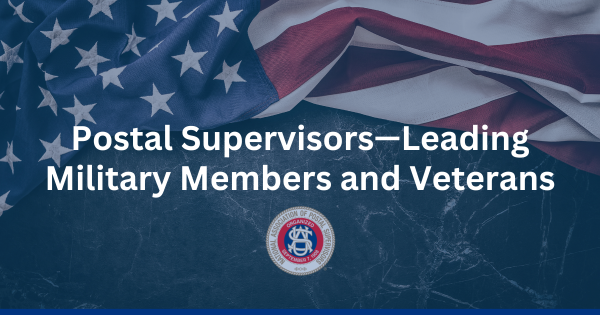Postal Supervisors—Leading Military Members and Veterans
Submitted by the USPS Employee Assistance Program
The United States Postal Service long has been a leading employer of veterans and military members, offering stable and meaningful career opportunities for those transitioning to and from military service. Many USPS employees return to civilian jobs after years of serving in structured, high-stakes environments.
These individuals bring valuable skills and experiences that can enhance workplace productivity and culture. However, their transition also can present unique challenges that USPS managers and supervisors should be prepared to address.
Understanding the Transition Process
Adjusting to civilian work at the Postal Service can be a significant shift, particularly for those accustomed to military structure. Employees may experience difficulty adapting to a different chain of command, communication styles or expectations.
Managers who recognize these challenges and offer support can make a meaningful difference in easing this transition and ensuring long-term retention.
Appreciating the Unique Strengths of USPS Veterans
Veterans transitioning into USPS roles bring a wealth of skills that benefit operations across all departments. These individuals excel in leadership, teamwork, adaptability, problem-solving, tenacity and discipline. Their ability to work under pressure, follow through on commitments and think strategically make them valuable assets.
Recognizing and appreciating these strengths allows managers to integrate them effectively into the workforce and optimize their potential.
The Role of Empathy in Leadership
A key element in successfully integrating veterans into the USPS is empathy. Managers and supervisors should take the time to understand the unique experiences of veterans and the challenges they face when transitioning back into civilian work. Empathetic leadership involves active listening, patience and creating a supportive environment where veterans feel valued.
By demonstrating compassion and recognizing the personal and professional adjustments required, managers can foster trust and encourage open communication, making the transition smoother for everyone involved.
Key Strategies for USPS Managers
1. Open communication—Encourage employees to share their concerns and experiences, ensuring they feel heard and valued. Providing a welcoming environment fosters trust and helps veterans integrate more smoothly into USPS roles.
2. Clear onboarding—A comprehensive onboarding program tailored for veterans can help them understand USPS policies, workplace culture and expectations. Addressing transition concerns during onboarding can further enhance their adjustment.
3. Mentorship opportunities—Pairing veterans with experienced USPS employees, especially fellow veterans, can provide guidance and a sense of camaraderie. Mentorship programs help new employees navigate their roles and establish valuable professional relationships.
4. Flexibility and patience—Recognizing that adjustment takes time is crucial. Offering flexible work arrangements, when possible, additional training or gradual workload increases can help veterans gain confidence in their new roles.
5. Training and skill development—Encouraging ongoing learning and professional growth allows returning employees to refine their skills and contribute more effectively to USPS operations.
How to Lead and Use Skillsets at the USPS
Leading veterans in the USPS requires an understanding of their work ethic and mindset. These individuals thrive in structured environments, appreciate clear expectations and respond well to mission-driven leadership. To maximize their potential:
Assign leadership roles—Many veterans have experience leading teams in high-pressure situations. Giving them opportunities to lead shifts, manage logistics or mentor others allows them to leverage their strengths.
Use problem-solving abilities—Veterans are skilled at making quick, strategic decisions and maintaining efficiency. Placing them in roles that require critical thinking, logistics coordination and operational problem-solving can yield great results.
Foster a sense of purpose—Veterans often excel when they see a clear mission. Reinforcing how their work at the Postal Service contributes to the country’s essential mail and package delivery system enhances engagement and motivation.
Encourage collaboration—Teamwork is a core strength for many veterans. Encouraging cross-functional collaboration between postal carriers, distribution workers and administrative staff allows them to apply their leadership and communication skills effectively.
As the USPS continues to evolve, understanding and supporting veterans transitioning back into civilian work remain key factors in building a strong, inclusive and high-performing workforce. By implementing thoughtful strategies, the agency can ensure every employee has the opportunity to thrive while maintaining the high standards of service for which the organization is known.
For more information and additional guidance on supporting those who serve our country, reach out to the EAP—800-327-4968 (800-EAP-4YOU); TTY: 877-492-7341; or visit EAP4YOU.com.
